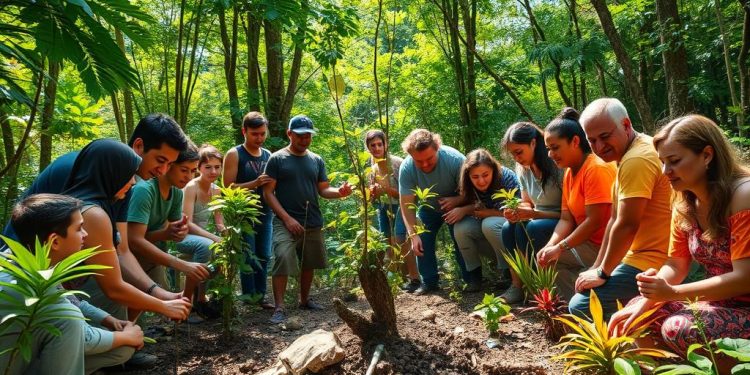Reforestation projects play a critical role in addressing climate change. By restoring tree cover to areas that have lost their forests, these initiatives not only enhance local ecosystems but also contribute significantly to carbon sequestration—the process through which trees absorb carbon dioxide from the atmosphere. This is especially important as global temperatures continue to rise, affecting biodiversity and community health.
In the United States, the Mississippi Valley reforestation project aims to reforest one million acres, which once supported millions of hectares of dense forest. Globally, projects in places like Ghana have created over 1,000 jobs, with a notable emphasis on involving women in sustainable forestry practices. By focusing on diverse species and engaging communities, reforestation projects are proving to be effective tools for climate change mitigation and environmental restoration.
Understanding Reforestation and Its Importance
Reforestation plays a crucial role in combating climate change and promoting environmental restoration. Understanding the definition of reforestation and its significance is essential for appreciating its impact on sustainable ecosystems.
Definition of Reforestation
The definition of reforestation refers to the process of planting trees in areas where forest cover has been lost, degraded, or destroyed. This typically occurs within a timeframe of ten to fifty years and often encompasses fostering natural regeneration, as well as promoting growth in disturbed areas. Effective reforestation strategies are essential, as many initiatives fail due to inadequate monitoring of saplings, which can suffer from pests and extreme weather conditions.
The Role of Trees in Carbon Sequestration
Trees serve as vital agents for carbon sequestration, absorbing approximately 2.6 billion tons of carbon dioxide annually. Mature forests represent some of the largest carbon sinks on the planet. Through the process of photosynthesis, healthy trees not only capture carbon dioxide but also provide essential benefits such as soil stabilization and habitat for diverse species. The varying growth rates of different tree species show distinct carbon absorption capabilities. For instance, bamboo reaches maturity in 5 to 6 years, while seedlings may take 12 weeks to 3 years to grow into plantable saplings. Thus, careful planning in reforestation efforts is necessary to sustain local ecosystems and enhance biodiversity.
Benefits of Reforestation Projects
Reforestation projects provide significant advantages that contribute to both environmental health and community well-being. These initiatives address pressing issues such as climate change mitigation and the enhancement of biodiversity and wildlife habitat. Understanding these benefits is crucial for recognizing why reforestation is essential in today’s world.
Climate Change Mitigation
One of the most impactful reforestation benefits lies in its potential for climate change mitigation. Trees have the capacity to capture and store massive amounts of carbon dioxide, with studies indicating they can absorb up to 205 gigatons of carbon over multiple decades. This is vital as it helps counteract the emissions produced by human activities. Restoring damaged ecosystems directly mitigates the adverse effects of climate change. Healthy forests play a crucial role in maintaining the balance of our atmosphere, allowing communities to adapt to and thrive in a changing climate.
Enhancing Biodiversity and Wildlife Habitat
The importance of reforestation extends beyond reducing carbon footprints, as it plays a vital role in enhancing biodiversity and providing wildlife habitat. Restored forests create essential environments for over 3,000 vertebrate species, including more than 400 federally listed threatened and endangered species. These efforts contribute to stabilizing ecosystems, protecting watersheds, and promoting environmental sustainability. By fostering rich biodiversity, reforestation not only combats climate change but also supports various wildlife populations, enriching the natural world.
| Reforestation Benefits | Impact on Climate Change | Impact on Biodiversity |
|---|---|---|
| Carbon Sequestration | Captures up to 205 gigatons of carbon | Supports over 3,000 vertebrate species |
| Pollution Reduction | Acts as a natural air filter | Provides habitat for federally endangered species |
| Flood Resilience | Enhances recovery from severe weather events | Improves ecosystem stability |
| Community Support | Boosts local tourism and recreation | Promotes outdoor activities |
Key Techniques in Reforestation
Reforestation efforts hinge on several key techniques in reforestation that facilitate the restoration of ecosystems and enhance biodiversity. Understanding these methods can empower communities and stakeholders to make informed decisions about implementing effective reforestation strategies.
Natural Regeneration
Natural regeneration allows areas to recover naturally, fostering restoration with minimal human intervention. This technique exhibits high regeneration rates, especially through methods like Farmer Managed Natural Regeneration (FMNR), which supports rapid restoration in previously degraded zones. You can maintain biodiversity and promote ecological balance, ensuring that native species thrive without significant disturbance.
Assisted Natural Regeneration
Assisted natural regeneration enhances the natural processes by managing invasive species and selectively planting certain tree varieties. This method can accelerate recovery in severely degraded landscapes and improve ecological balance. The integration of seed balls can speed up germination processes, typically occurring within just a few days. By utilizing native and fast-growing seed species, you can significantly increase the chances of success.
Tree Planting Initiatives
Tree planting initiatives represent a proactive approach to reforestation, focusing on directly planting trees in deforested regions. These efforts can yield significant benefits, particularly when combining community involvement and strategic species choices. Seedling nurseries can hold between 25,000 to 400,000 seedlings at any given time, heightening survival rates and facilitating growth. Utilizing the bare root planting method enhances survival by relocating seedlings to environments with optimal light conditions.
Direct seedling planting mirrors natural regeneration and improves cost and time efficiency, particularly advantageous for large-scale reforestation projects. This method can be complemented by the use of mangrove propagules, which thrive and mature in just three to five years. You can ensure the success of these initiatives by prioritizing native species, which should make up at least 90% of the planted trees, thus reinforcing the local ecosystem and enhancing overall biodiversity.
The Reforestation Hub: Mapping Opportunities
The Reforestation Hub serves as a crucial resource for identifying optimal locations for reforestation efforts. By utilizing advanced mapping opportunities, this platform ensures that areas chosen for tree planting have a significant impact on both carbon capture and the health of local ecosystems.
Identifying Low-Cost Reforestation Areas
The Reforestation Hub provides a detailed web-based platform that highlights feasible reforestation opportunities. It analyzes critical factors such as land cover and historical forest locations to pinpoint areas where planting trees is both effective and economically viable. With approximately 68 billion trees needed to restore ecologically appropriate areas across the Lower 48 states, the Hub becomes invaluable in this effort. It identifies regions, including Missouri, Kentucky, and Tennessee, where reforestation can thrive without incurring excessive costs.
Effects on Carbon Capture and Local Ecosystems
Utilizing the Reforestation Hub can result in capturing an impressive 333 million metric tons of carbon dioxide each year. This figure represents a significant reduction in greenhouse gas emissions, comparable to the yearly emissions of 72 million cars. Additionally, the platform facilitates a deeper understanding of local ecosystems, ensuring that reforestation strategies align with both environmental needs and the potential for long-term habitat restoration. Identifying opportunities for reforestation can dramatically enhance biodiversity, especially in areas where species-rich habitats, like those provided by white oaks, are crucial for attracting various wildlife.
Reforestation Projects Around the World
Globally, reforestation projects offer significant hope in the fight against climate change. This section explores two notable efforts: the Mississippi Valley Reforestation Effort and the community-led ventures in Ghana. Each project demonstrates how localized actions can lead to substantial ecological benefits.
Case Study: The Mississippi Valley Reforestation Effort
The Mississippi Valley initiative aims to restore one million acres of forested land that has suffered from significant deforestation. This large-scale project focuses on enhancing habitat conditions while mitigating flood impacts. In addition to ecological benefits, the project promotes sustainable forest extraction practices, allowing for job creation and community engagement. Such efforts exemplify effective global reforestation projects that harness local resources for widespread benefit.
Community-Led Reforestation in Ghana
In Ghana, community-led initiatives have gained traction by involving local farmers in tree-planting activities. These efforts emphasize the use of indigenous species, which not only enrich biodiversity but also promote sustainable agricultural practices. Farmers participating in these projects benefit from job creation and access to resources necessary for maintaining their livelihoods. This model highlights the importance of local involvement in global reforestation projects, ensuring that communities play an active role in revitalizing their environment.
Challenges Facing Reforestation Efforts
Reforestation initiatives face numerous challenges that hinder their success. Understanding these challenges helps us appreciate the intricate dynamics of restoring forest ecosystems. Two primary hurdles include land use competition and the ongoing necessity for forest maintenance.
Land Use Competition and Deforestation Prevention
A significant challenge in reforestation stems from land use competition, especially as agricultural and urban development press for additional space. The opportunity costs related to maintaining forested areas often exceed potential profits from agriculture or real estate, leading to difficult decisions regarding land management. Protecting existing forests becomes vital for successful reforestation efforts, as deforestation in regions such as the Brazilian Amazon demonstrates the complex interplay between development and conservation.
Organizations involved in reforestation reveal that around 90% find obtaining the right seeds and understanding advanced topics, like genetic diversity, crucial for successfully expanding forest cover. Many reported financial hurdles, with an alarming 95% lack sufficient funding to achieve their goals. As interest in selling carbon credits grows, these financial mechanisms may provide some relief, yet a clear strategy must address land tenure issues affecting land rights and ownership.
Monitoring and Maintaining Newly Planted Forests
Monitoring newly planted forests poses another significant challenge in the reforestation landscape. Effective forest maintenance is critical to promote tree survival and overall ecosystem health. Compliance costs, including human and financial capital, can strain resources. Moreover, 70% of projects reportedly lack the necessary technology for accurate tracking, escalating potential issues related to pest control, disease management, and climate impacts.
Organizations show that about 60% collect some of their seeds, while 80% depend on purchasing seeds and saplings. Despite these efforts, nearly 50% report insufficient storage for seeds, impeding access to vital resources. In addition to ecological factors, economic challenges persist as many initiatives struggle with establishing comprehensive strategies that fit both ecological and commercial objectives.
| Challenge | % of Organizations Affected |
|---|---|
| Lack of Sufficient Funding | 95% |
| Interest in Selling Carbon Credits | 54% |
| Lack of Access to Seeds | 65% |
| Projects Missing Technology for Monitoring | 70% |
| Not Storing Seeds Properly | 50% |
Confronting these challenges in reforestation requires coordinated efforts across multiple sectors. By investing in technology and resources, you can help establish frameworks that cultivate sustainable forest ecosystems for future generations.
Reforestation Projects: Future Perspectives
Fostering sustainable environmental practices has become increasingly urgent, especially in relation to the future of reforestation. Financial mechanisms such as carbon finance present significant opportunities to catalyze growth in this vital sector. Market-driven carbon credits can incentivize reforestation projects, attracting investment while enabling large-scale restoration efforts.
The Potential of Carbon Finance
Carbon finance offers a promising avenue to fund reforestation initiatives. Investors gain access to high-quality offsets that stem from successful projects, which are instrumental in promoting environmental stability while generating economic benefits. By harnessing this financial model, organizations can channel resources into restoring forests, thus enhancing their role in carbon sequestration. For instance, trees can store around 50% of carbon in kiln-dried wood. Young forests, in particular, excel in this area, despite variability based on species and age.
Global Efforts and Collaborations
The importance of global partnerships cannot be overstated in the realm of reforestation. Initiatives like the African Forest Landscape Restoration Initiative serve as examples of countries uniting to bolster their reforestation efforts. By sharing knowledge and financial resources, these collaborations can influence national policies, restore biodiversity, and advance climate change mitigation. Through such global efforts, new strategies emerge that not only address reforestation needs but also ensure sustainable management of forest ecosystems across different regions.
| Year | Reforested Area (Acres) | Methods Used |
|---|---|---|
| 2020 | 60,000 | Tree Planting |
| 2020 | 130,000 | Natural Regeneration |
| 2021 | 200,000 | Assisted Natural Methods |
| 2022 | 210,000 | Aerial Reforestation |
| 2023 | 190,000 | Mix of Natural and Artificial |
Conclusion
The growing urgency of addressing climate change is underscored by alarming statistics, such as the loss of approximately 10 million hectares of forests each year due to deforestation. This alarming rate of deforestation, estimated at roughly 35 football fields every minute, not only contributes to around 10% of global greenhouse gas emissions but also threatens the 80% of the world’s terrestrial biodiversity that thrives in these ecosystems. Therefore, the conclusion on reforestation becomes clear: proactive landscape restoration is essential for our planet’s health and longevity.
Reforestation initiatives play a crucial role in improving air quality and regulating local climates, thereby mitigating the environmental challenges we face, including natural disasters like floods and landslides. When executed effectively, these efforts significantly enhance the air we breathe by absorbing pollutants and improving overall ecological integrity. However, the real challenge necessitates a call to action that transcends individual projects; a concerted global effort is required to restore ecosystems on a broader scale and enhance biodiversity.
You have a vital role in this initiative by engaging with local reforestation projects and realizing how your actions contribute to a more sustainable future. Every small step, whether it’s advocating for tree planting in your community or supporting ecological initiatives, can make a significant difference. Ultimately, the collective commitment to reforestation not only addresses the climate change impact but also fosters a renewed bond with nature for future generations.






